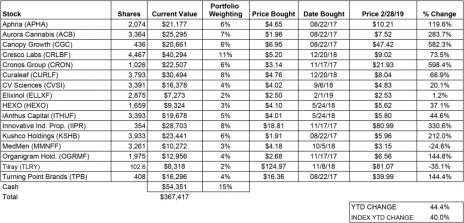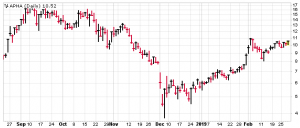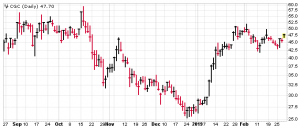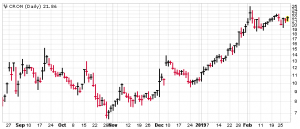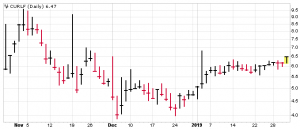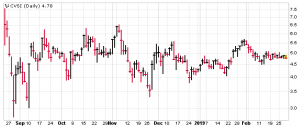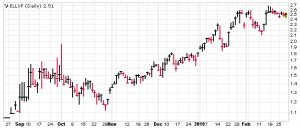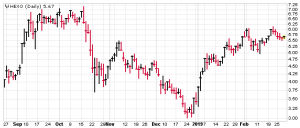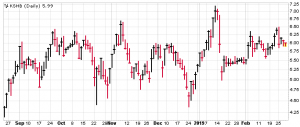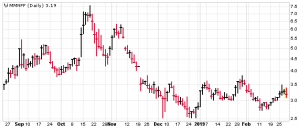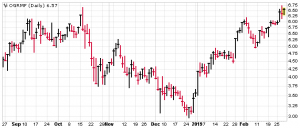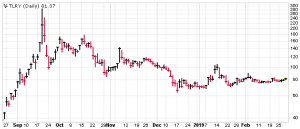The latest issue of Cabot Marijuana Investor is now available, with my current advice on the sixteen stocks in the portfolio.
The gains so far this year, in both the sector and the portfolio, have been absolutely spectacular, but they won’t continue. Already I detect signs of a rolling correction and there’s the possibility that short-term, it could get worse. So in this issue, I have some sell recommendations, for investors who are working to develop maximum gains.
For longer-term, more patient investors, however, doing nothing is fine. The long-term prospects for both the industry and the sector remain bright.
Cabot Marijuana Investor 219
Strength and Rotation
Sometimes investing is easy; sometimes it’s difficult. 2019 has been a piece of cake, so far, especially for investors in marijuana stocks.
While the S&P 500 is up 11.1%, year-to-date, the Marijuana Index is up 40.0%, and our own Marijuana Portfolio is up 44.4%. Times are good.
Demand for marijuana stocks continues to exceed supply, as new investors are drawn to the sector by a combination of a desire to buy the hottest stocks and a growing acceptance of this increasingly legal American industry.
And the companies in the industry are quickly getting their acts together, learning how to communicate with investors, replacing entrepreneurial founders with experienced management teams and working hard to refine their business plans, aiming where they expect the demand, revenues, efficiencies of scale and earnings to be greatest in the future.
But the current stock surge won’t last forever; in fact, many of the previous leaders in the group, including Aphria, Aurora, Canopy and Cronos, saw their surge end February 4, and the action since then has been more about the secondary stocks in the sector finding buyers, rather than those leaders pushing higher.
Call it rotation, if you will. Or call it a rolling correction. The effect is visible in the Marijuana Index, which has yet to top its February 4 high.
What’s Next?
So what might come next, and what’s the game plan?
First, know that it’s an exercise in futility to attempt to call market tops. But it is easy to lean against the wind. And given the unremitting strength of the broad market since Christmas, combined with the rolling correction in the marijuana sector, I think the odds now favor a pause—and maybe even some pain—for the sector.
I could, of course, be early. The broad market may continue higher for many more weeks and marijuana stocks may continue to lead the parade. Nevertheless, in the portfolio I will now reduce exposure by selling a few laggards and trimming back on a couple of stocks because their charts are extended, their valuations are high or the position size has simply grown uncomfortably large.
Think of it as easing up a bit on the gas pedal. If the stocks keep climbing, our performance will soon begin to lag. But if the sector rolls over, we will give back less of our gains—and we’ll be able to put the money back in at a lower-risk entry point!
Long-term, of course, the prospects for the industry and the sector remain spectacular, so if you simply want to sit tight, that’s fine too, especially if marijuana investments are a minor part of your portfolio.
And if you’re just joining us, don’t let this talk of selling scare you. There’s plenty of guidance on what to buy, and at what level, in the stock update section.
Investing Strategy
Finally, a few tips on overall investing strategy in the sector.
Many of these stocks are lower-priced, which generally means they will be more volatile. The way to deal with that is to try to buy on corrections, to spread your buying over time and (above all) to practice the number one rule of successful investing—diversify. The more stocks you own in a sector, the less subject you are to the fluctuations of any one stock.
WHAT TO DO NOW
In the portfolio, we will sell all of CV Sciences (CVSI), MedMen (MMNFF) and Tilray (TLRY) and a third of Cresco Labs (CRLBF) and Innovative Industrial Properties (IIPR). All these transactions will be recorded tomorrow, using the average price of the day. After the sales, the portfolio will be about 30% in cash, which I hope to reinvest soon—and at more advantageous buy points.
CURRENT RECOMMENDATIONS
The portfolio was started with a hypothetical $100,000 on August 22, 2017.
Aphria (APHA)
APHA posted the third-largest revenues among Canadian producers in its most recent quarter, but that was “only” 63% higher than the same quarter the year before, which is slow for the group and thus a little worrisome. Still, the stock has bounced back impressively from the December bottom—it’s up more than 100%—and its current pattern of consolidation looks quite constructive.
If you don’t own it, the stock would be an attractive buy on a pullback to between 8 and 9.
Note: Management recommends that you reject the hostile takeover offer from Green Growth Brands (GGBXF), and I expect it to be easily defeated.
Aurora Cannabis (ACB)
Aurora posted the second-largest revenues among Canadian producers in its most recent quarter, as well as a fantastic growth rate of 363% from the year before. That pace can’t last, of course, but it’s a sign that management has been quite skillful at scaling operations as the Canadian market added recreational use to medical, and in adding international operations; Aurora currently has sales and operations in 22 countries.
If you don’t own it (or are looking to average up) I suggest trying to buy at 7 or—if things really fall apart—at 6.
Canopy Growth (CGC)
Still leading the pack, with a market capitalization of over $15 billion and revenues of $72 million in the latest quarter, and with the backing of Constellation Brands, Canopy (the company) has excellent growth prospects, as well as the most recognized cannabis brand in the world, Tweed. Think of it as the Marlboro of marijuana. And Canopy has international operations in eight countries.
But as I’ve mentioned before, the stock is selling at a substantial premium to its peers, so I don’t think it’s an attractive buy here—though if you really want to own a piece of it, the 35 price level looks attractive on the chart.
The portfolio most recently sold a third of its CGC position on February 19 (when it was the largest position in the portfolio) at 49.6.
Cresco Labs (CRLBF)
Chicago-based Cresco Labs is one of the leading vertically integrated multi-state operators in the U.S., where federal laws still dictate a state-by-state approach to business. Cresco counts seven operational states (California, Nevada, Arizona, Illinois, Ohio, Pennsylvania and Massachusetts), with 10 production facilities and 16 retail locations—and revenue growth of 350% in the latest quarter as it expands rapidly.
But the stock is a bit of a puzzle to me. It has the lowest average trading volume in the portfolio, signifying that it’s not particularly visible. And by my calculations, it’s still one of the least overvalued stocks in the portfolio—which is one reason we averaged up on February 19 at 7.2.
But now Cresco is the biggest position in the portfolio (11% of the total), and the chart tells me it could easily pull back to 7.5 or even lower, so the portfolio will now sell a third of its position and hold the cash.
Cronos Group (CRON)
Back in Canada, Cronos, soon to be 45% owned by Altria, is the second-most heavily traded stock in the portfolio; if you’re an institutional investor, the thinking is, you’ve got to own CRON (as well as CGC).
But by my measurements, CRON is the most overvalued stock in the portfolio; investors are hoping for a lot from Altria, even though revenues at Cronos last quarter were just $3.8 million.
Furthermore, the longer-term pattern I see tells me that CRON peaked on February 4 and has been digesting that gain since. The portfolio sold a third of its position in the stock on February 19 (when it was the second-largest position in the portfolio) at 20.9, and now I’m tempted to sell a third again, taking CRON to an underweight position.
However, Jacob Mintz, Cabot’s options expert, just yesterday wrote about heavy call buying in CRON and recommended a trade for his readers—his first in the marijuana sector—and that has me pausing as my finger hovers over the sell button. Jacob is good—his options trades, overall, are quite profitable for his readers—so adding his intelligence to my calculation convinces me to stick with it for now, as long as the stock holds up above 19.
And if you’re interested in using options in this sector, or in any sector for that matter, take a look at Jacob’s offerings on the Cabot website, or by subscribing to his Cabot Options Trader advisory by clicking here.
Curaleaf Holdings (CURLF)
Massachusetts-based Curaleaf is active in 11 states and just yesterday announced an acquisition in California that will increase its footprint further. The stock, which only came public at the end of October, was added to the portfolio at the same time as Cresco (December 20) and has performed nearly as well since. Both companies have great prospects as vertically integrated multi-state operators, but Curaleaf looks more expensive to me. Still, both charts look very healthy, marching steadily higher. If you don’t own it, you could try to wait for a dip toward 7, but if you don’t want to wait, you could nibble here and average up if all goes well.
CV Sciences (CVSI)
CVSI was the portfolio’s first stock focused on cannabidiol (CBD), and we were lucky to get in soon after the selloff last August, but the stock hasn’t made any real progress for five months. In the last update I mentioned that I was waiting for the company’s fourth-quarter report, and just yesterday the company mentioned that the report will finally be released after the market close on March 12—which is farther away than I’d like, and adds to my fear that the news won’t be particularly good. So, instead of continuing to hold patiently, which might work out, I’m going to sell here, take our profit and hold the cash. Sell.
Elixinol (ELLXF)
Elixinol is the portfolio’s most recent addition and one of the CBD companies that is competing in an increasingly crowded field. But while CVSI made no progress over the past five months, ELLXF roughly doubled. If you don’t own it, you could nibble here, though more risk-averse buyers (it’s all relative) should hope for a pullback to 2.3, or even 2.1.
HEXO Corp. (HEXO)
I once called HEXO the company with the prettiest marijuana packaging, and while the field has gotten a lot more crowded since then (that was back when the company was called Hydropothecary), I still think HEXO has great marketing and branding skills, and that these skills will become an important differentiator as the retail market evolves. As the Canadian stocks go, this one seems moderately valued, and the chart has a decent long-term uptrend established. I previously wrote that the stock could be bought on a correction toward 5 and that is still true, but if you’re impatient, you can buy some here.
iAnthus Capital (ITHUF)
iAnthus last week opened its 20th U.S. dispensary (in the Hudson Valley of New York), so the company now has 63 dispensaries and 15 cultivation/processing operations in eleven states, with the vast majority of them achieved via acquisitions—11 since the start of 2018.
The stock is expensive relative to its U.S. peers, but the chart is very bullish, with positive volume trends as well, telling me that more and more investors are betting on iAnthus—and its management. If you don’t own it, you can nibble here, though a dip toward 5 would offer a lower-risk entry point.
Innovative Industrial Properties (IIPR)
Innovative Industrial Properties is a real estate investment trust (REIT) that as of February 8 owned 12 properties located in Arizona, California, Colorado, Illinois, Maryland, Massachusetts, Michigan, Minnesota, New York and Pennsylvania, totaling approximately 1,070,000 rentable square feet. The stock is here for diversification as much as anything, but it’s exceeded all expectations!
So last week when the stock was trading way down at 68, I wrote, “Partial profit-taking is an option here, and I’ve considered it for the portfolio, where the stock now has a 7% weighting. But in the end I’ve decided to sit tight. The weekly chart in particular remains very bullish.” And now, one week later, the stock has topped 80!
And this is a REIT, which is up 78% for the year! My best explanation is that demand for this safe and legal piece of the marijuana business exceeds supply; after all, it’s the only marijuana REIT out there. But while last week the stock was sitting on a nice little base, now the stock is quite extended (albeit with supporting volume) and thus vulnerable to a pullback, or at least a very long period of consolidation. So now I will take some profit, selling one-third of the portfolio’s position. In your own portfolio, if it’s a small position and you’ve got a nice profit, you could just sit tight; maybe it will go even higher. But someday, gravity will have its say; take a look at the weekly chart below. Fourth-quarter results will be announced on March 13, after the market close.
KushCo Holdings (KSHB)
KushCo is another diversification play; by dealing with totally legal ancillaries to the marijuana industry, like packing and industrial gasses and marketing, it operates seamlessly across the U.S. In the most recent quarter, revenues grew at triple-digit rates, in part because of acquisitions. KSHB’s chart has been going sideways for more than a year, but there is an upward bias to the chart, and I remain optimistic that it will come to life eventually. The portfolio most recently averaged up on February 19 at 5.5. If you don’t own it, you can buy here or on a pullback to 5.6.
MedMen (MMNFF)
MedMen released its fiscal second-quarter report yesterday after the close. Revenues of $29.9 million were up 39% from the fiscal first quarter and up 873% year-over-year, with 79% of revenues coming from the company’s eight California retail locations. Going forward, the company expects to open 16 new locations in the U.S. in 2019, 12 of which will be based in Florida; in the next 90 days, stores will open in Key West, Orlando, West Palm Beach, and St. Petersburg. It all sounds good. But the market didn’t like it, taking the stock down moderately this morning, Given that this follows a three-month period of treading water, it tells me that investors are not climbing on board and thus it’s time to take our loss and move on. Sell.
Organigram (OGRMF)
Valuation-wise, Organigram is attractive relative to its Canadian peers. And chart-wise, it’s quite impressive, having posted a record high close on Tuesday—just above its highs of September-October. And there’s good fundamental news to go along with this; the company just this week announced that it has signed a letter of intent with the Société Québécoise du Cannabis (SQDC), thus locking in distribution in all 10 Canadian provinces. The only other two licensed producers with that status are Canopy and Aphria. If you don’t own it, you can nibble here.
Tilray (TLRY)
Fundamentally, Tilray has long been perceived to have top management and great prospects—which is one reason it traded as high as 300 soon after coming public last September. But the stock, even well off that high, is still expensive relative to its peers—and the stock’s chart now has the profile of a snake crawling along the ground. Investors just aren’t buying it, and I’m tired of waiting. So, the portfolio will now take the loss and hold the cash, looking for better opportunities. Sell.
Turning Point Brands (TPB)
Turning Point Brands is the slowest growing company in the portfolio—it even pays a dividend—but its stock is up 47% since the start of the year! Last week I told you it looked too extended to buy and to wait for a pullback. And now we have a little one. Additionally, my latest look at valuations tells me that this company, which is transitioning from an old-school tobacco company to a new-age provider of ancillaries to the marijuana industry, still looks quite cheap. So if you’d like to own it, you can buy a little here. Fourth-quarter results will be released Tuesday March 5, before the market opens.
THE NEXT CABOT MARIJUANA INVESTOR WILL BE PUBLISHED March 28, 2019
Neither Cabot Wealth Network nor our employees are compensated by the companies we recommend. Sources of information are believed to be reliable, but are in no way guaranteed to be complete or without error. Recommendations, opinions or suggestions are given with the understanding that subscribers acting on the information assume all risks. © Cabot Wealth Network. Copying and/or electronic transmission of this report is a violation of U.S. copyright law. For the protection of our subscribers, if copyright laws are violated, the subscription will be terminated. To subscribe or for information on our privacy policy, call 978-745-5532, visit www.cabotwealth.com or write to support@cabotwealth.com.



